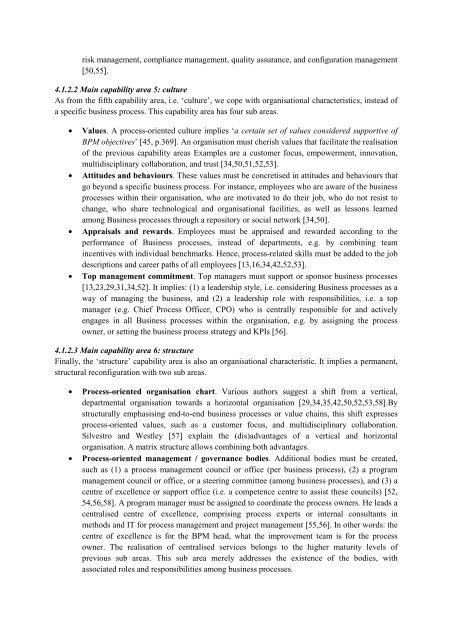A theoretical framework and classification of capability areas
A theoretical framework and classification of capability areas
A theoretical framework and classification of capability areas
You also want an ePaper? Increase the reach of your titles
YUMPU automatically turns print PDFs into web optimized ePapers that Google loves.
isk management, compliance management, quality assurance, <strong>and</strong> configuration management<br />
[50,55].<br />
4.1.2.2 Main <strong>capability</strong> area 5: culture<br />
As from the fifth <strong>capability</strong> area, i.e. ‘culture’, we cope with organisational characteristics, instead <strong>of</strong><br />
a specific business process. This <strong>capability</strong> area has four sub <strong>areas</strong>.<br />
• Values. A process-oriented culture implies ‘a certain set <strong>of</strong> values considered supportive <strong>of</strong><br />
BPM objectives’ [45, p.369]. An organisation must cherish values that facilitate the realisation<br />
<strong>of</strong> the previous <strong>capability</strong> <strong>areas</strong> Examples are a customer focus, empowerment, innovation,<br />
multidisciplinary collaboration, <strong>and</strong> trust [34,50,51,52,53].<br />
• Attitudes <strong>and</strong> behaviours. These values must be concretised in attitudes <strong>and</strong> behaviours that<br />
go beyond a specific business process. For instance, employees who are aware <strong>of</strong> the business<br />
processes within their organisation, who are motivated to do their job, who do not resist to<br />
change, who share technological <strong>and</strong> organisational facilities, as well as lessons learned<br />
among Business processes through a repository or social network [34,50].<br />
• Appraisals <strong>and</strong> rewards. Employees must be appraised <strong>and</strong> rewarded according to the<br />
performance <strong>of</strong> Business processes, instead <strong>of</strong> departments, e.g. by combining team<br />
incentives with individual benchmarks. Hence, process-related skills must be added to the job<br />
descriptions <strong>and</strong> career paths <strong>of</strong> all employees [13,16,34,42,52,53].<br />
• Top management commitment. Top managers must support or sponsor business processes<br />
[13,23,29,31,34,52]. It implies: (1) a leadership style, i.e. considering Business processes as a<br />
way <strong>of</strong> managing the business, <strong>and</strong> (2) a leadership role with responsibilities, i.e. a top<br />
manager (e.g. Chief Process Officer, CPO) who is centrally responsible for <strong>and</strong> actively<br />
engages in all Business processes within the organisation, e.g. by assigning the process<br />
owner, or setting the business process strategy <strong>and</strong> KPIs [56].<br />
4.1.2.3 Main <strong>capability</strong> area 6: structure<br />
Finally, the ‘structure’ <strong>capability</strong> area is also an organisational characteristic. It implies a permanent,<br />
structural reconfiguration with two sub <strong>areas</strong>.<br />
• Process-oriented organisation chart. Various authors suggest a shift from a vertical,<br />
departmental organisation towards a horizontal organisation [29,34,35,42,50,52,53,58].By<br />
structurally emphasising end-to-end business processes or value chains, this shift expresses<br />
process-oriented values, such as a customer focus, <strong>and</strong> multidisciplinary collaboration.<br />
Silvestro <strong>and</strong> Westley [57] explain the (dis)advantages <strong>of</strong> a vertical <strong>and</strong> horizontal<br />
organisation. A matrix structure allows combining both advantages.<br />
• Process-oriented management / governance bodies. Additional bodies must be created,<br />
such as (1) a process management council or <strong>of</strong>fice (per business process), (2) a program<br />
management council or <strong>of</strong>fice, or a steering committee (among business processes), <strong>and</strong> (3) a<br />
centre <strong>of</strong> excellence or support <strong>of</strong>fice (i.e. a competence centre to assist these councils) [52,<br />
54,56,58]. A program manager must be assigned to coordinate the process owners. He leads a<br />
centralised centre <strong>of</strong> excellence, comprising process experts or internal consultants in<br />
methods <strong>and</strong> IT for process management <strong>and</strong> project management [55,56]. In other words: the<br />
centre <strong>of</strong> excellence is for the BPM head, what the improvement team is for the process<br />
owner. The realisation <strong>of</strong> centralised services belongs to the higher maturity levels <strong>of</strong><br />
previous sub <strong>areas</strong>. This sub area merely addresses the existence <strong>of</strong> the bodies, with<br />
associated roles <strong>and</strong> responsibilities among business processes.

















